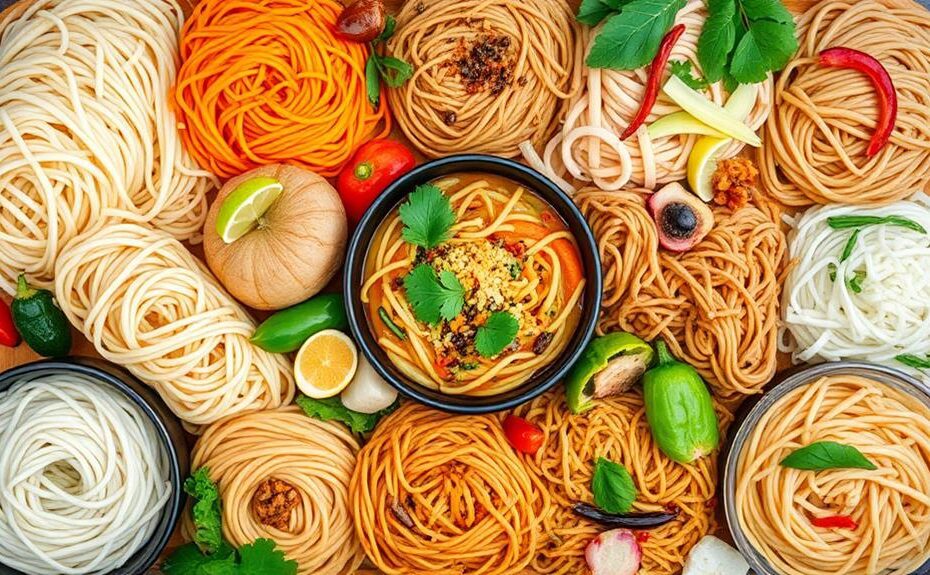Each type of pancit is unique due to its cultural significance, regional specialties, and diverse cooking methods.
The noodles used in different pancit types vary significantly. For instance, Pancit Abra features thick egg noodles, while Pancit Malabon is made with thin rice noodles. These noodles are often paired with local ingredients and traditions, resulting in distinct flavor profiles.
Cooking techniques also differ between pancit types, with some being stir-fried and others being soupy. The ingredients used can range from rice vermicelli to mung bean sprouts, adding to the diversity of pancit dishes.
Unique toppings and seasonings further distinguish each pancit type, making every dish tell a story.
The rich history and cultural importance behind pancit are evident in its many variations, waiting to be discovered.
Cultural Significance of Pancit
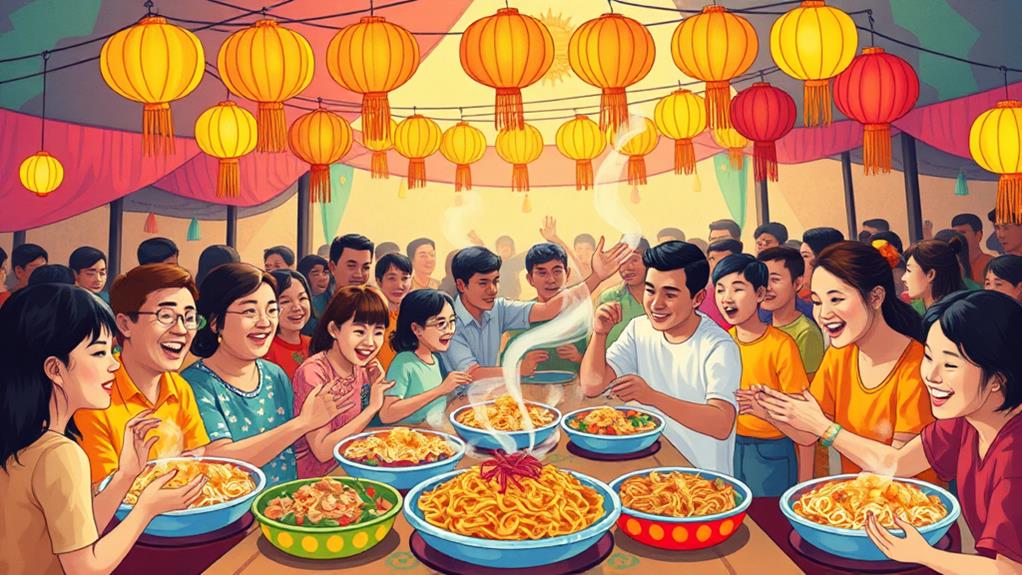
Pancit's Cultural Significance
In Filipino culture, pancit symbolizes long life and prosperity. It's often served at birthday celebrations and special occasions to convey good fortune.
Fusion of Filipino and Chinese Culinary Traditions
Pancit embodies the fusion of Filipino and Chinese culinary traditions, reflecting the historical influence of Chinese immigrants in the Philippines.
This cultural blend is evident in the dish's ingredients and cooking techniques, which have been adapted to suit local tastes.
Communal Significance
Pancit is a communal dish that emphasizes the importance of shared meals in Filipino culture. It's often served during family gatherings and celebrations, fostering a sense of community and togetherness.
Regional Variations
The diverse regional identities within Filipino cuisine are showcased through unique pancit dishes across different regions, highlighting local ingredients and culinary practices.
For example, Pancit Habhab from Quezon Province uses rice flour noodles, while Pancit Lugaw from the Visayas region features a thick, savory broth.
Comfort Food and Versatility
As a comfort food, pancit's versatility allows for endless adaptations, making it a beloved staple that evolves while maintaining its traditional roots.
This adaptability has contributed to pancit's enduring popularity in Filipino cuisine.
Regional Variations and Specialties
Regional Variations and Specialties
Filipino cuisine's cultural diversity is reflected in pancit's regional variations and specialties. Each region in the Philippines offers a unique take on this beloved noodle dish.
Northern Luzon's Pancit Abra
In Northern Luzon, Pancit Abra features thick egg noodles and a savory broth, often loaded with local veggies and meats.
Cebu's Pancit Bam-I
In Cebu, Pancit Bam-I combines thin rice noodles and egg noodles, stir-fried with seafood, pork, and veggies for a flavorful dish.
Naga City's Pancit Kinalas
In Naga City, Pancit Kinalas stands out with its thick sauce made from beef broth, topped with scraped meat and served with egg noodles and a boiled egg.
Malabon City's Pancit Malabon
In Malabon City, Pancit Malabon showcases thick rice noodles in a shrimp sauce with a distinctive orange hue, topped with seafood and chicharrón, making it a rich and hearty dish.
Each regional variation offers a distinct twist, yet they all share a common thread – a delicious celebration of pancit noodles.
Cooking Methods and Ingredients
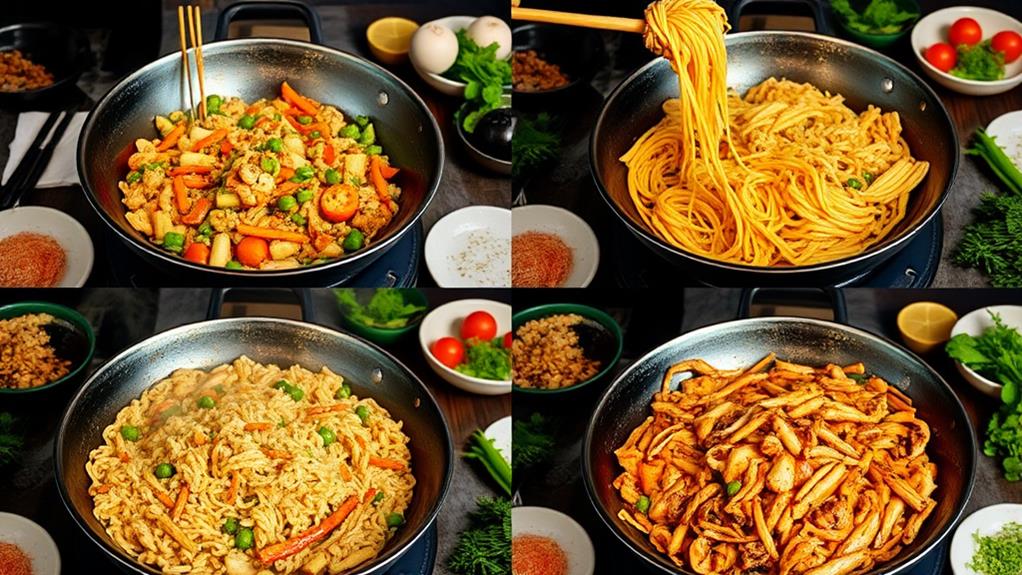
Diverse Cooking Methods and Ingredients Define Pancit Types
Across various pancit types, different cooking methods and ingredients set each dish apart.
Stir-frying is a common method for Pancit Canton and Pancit Bihon, while Pancit Lomi is prepared as a hearty, soupy dish with thick egg noodles.
Ingredients Vary by Pancit Type
Ingredients used in Pancit also differ by type.
Pancit Bihon features thin rice vermicelli, Pancit Canton uses egg-based wheat noodles, and Pancit Malabon boasts thick rice noodles in a shrimp sauce.
Seasonings Enhance Flavors
Seasonings play a crucial role in enhancing the flavors of Pancit.
Soy sauce, oyster sauce, and fish sauce frequently enhance the flavors of stir-fried varieties like Pancit Chami and Pancit Habhab.
Vegetables Add Texture and Nutrition
Vegetables like carrots, cabbage, and snow peas add texture and nutritional value to many Pancit dishes.
Toppings Allow Personalization
Unique toppings such as chicharrón, hard-boiled eggs, and seafood like shrimp and mussels allow you to personalize and elevate your Pancit presentation.
Unique Noodle Types and Textures
Exploring Pancit's Diverse Noodle Types and Textures
The world of Pancit offers a fascinating array of noodle types and textures, each with unique characteristics that set them apart and make them suited for specific cooking methods and sauces.
Pancit Bihon: Delicate and Flavor-Absorbing
Pancit Bihon features thin rice noodles made from cornstarch and rice flour, known for their delicate texture that absorbs flavors well in stir-fries and soups.
Pancit Canton: Thicker and Sturdier
In contrast, Pancit Canton utilizes wheat flour and egg-based noodles, which are thicker and sturdier, making them ideal for stir-frying while holding their shape during cooking.
Other Varieties of Pancit
Other pancit varieties showcase different textures, such as Pancit Lomi's wide, thick egg noodles that offer a chewy texture, often used in hearty soups that enhance their springy qualities.
Pancit Misua, on the other hand, is made from extremely thin salted wheat noodles, typically used in soups where their lightweight and delicate nature complements rich broths.
Lastly, Pancit Miki features fresh egg noodles that can either be flat or round, providing a versatile option that's commonly used in both stir-fried and soupy dishes.
Non-Noodle Pancit Variants
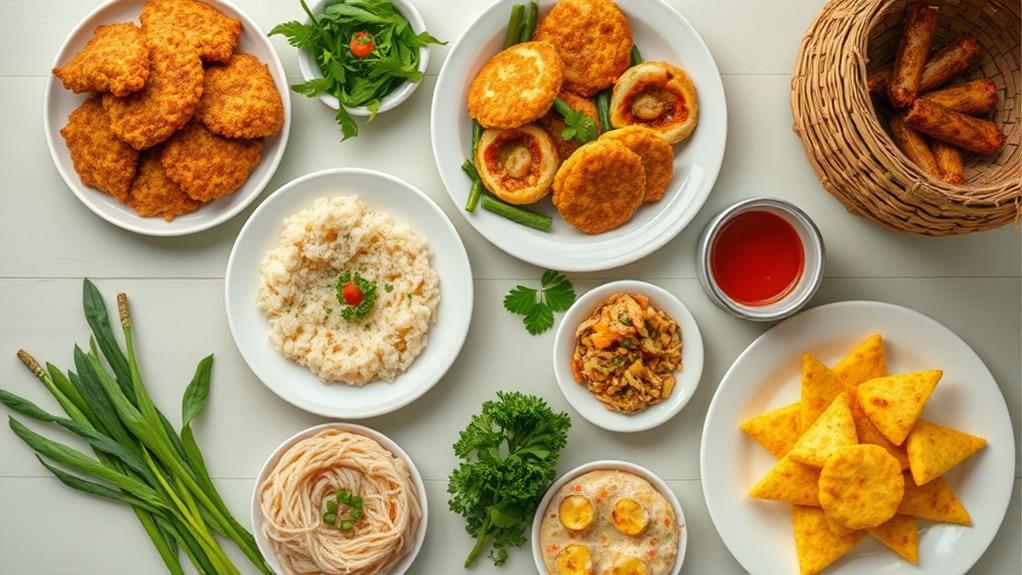
Beyond traditional noodles, Pancit takes on a new dimension with non-noodle variants that showcase creative substitutes.
These alternatives offer unique textures and flavor profiles. For instance, Pancit Buko utilizes long strips of coconut as a noodle substitute, providing a distinct texture and flavor.
Pancit Kilawin replaces noodles with shredded unripe papaya, creating a fresh and light dish often paired with dinuguan, a savory pork blood stew.
Other notable examples include Pancit Estacion, which features mung bean sprouts as the primary ingredient, showcasing a crunchy texture and a specialty from Tanza, Cavite.
Pancit Labong uses julienned bamboo shoots instead of conventional noodles, providing a distinctive earthy flavor and a crunchy bite in the dish.
Pancit Molo employs wonton wrappers as a noodle alternative in a soup, delivering a comforting and hearty experience, typically filled with meat or shrimp.
These innovative takes on Pancit showcase the versatility of Filipino cuisine, where traditional dishes can be reimagined with creative substitutes that offer distinct flavors and textures.
Pancit in Filipino Celebrations
Pancit is a staple dish in Filipino celebrations, taking center stage in birthdays, New Year's festivities, and family gatherings. This beloved noodle dish symbolizes long life and prosperity, emphasizing the cultural belief that eating noodles brings good fortune.
Traditional Filipino culture emphasizes communal sharing, and the preparation of pancit for special events often involves large quantities, allowing guests to share and reinforcing family ties and social bonds.
Pancit dishes like Pancit Palabok and Pancit Bihon are commonly featured in holiday feasts, reflecting the fusion of Chinese and Filipino culinary traditions that have evolved over time.
Serving pancit during celebrations highlights its significance as a comfort food, representing not just sustenance but also a connection to heritage and the joy of gathering with loved ones.
This comfort food represents a connection to heritage, bringing people together and evoking feelings of nostalgia and warmth.
What Makes Each Type of Pancit Unique in Flavor and Ingredients?
Pancit Canton is known for its distinct savory flavor, often made with pork, chicken, and shrimp. Pancit Bihon, on the other hand, is lighter in taste with a focus on rice noodles and vegetables. Each of these types of pancit explained showcases the diversity of Filipino cuisine through unique flavors and ingredients.
Evolution of Pancit in the Philippines
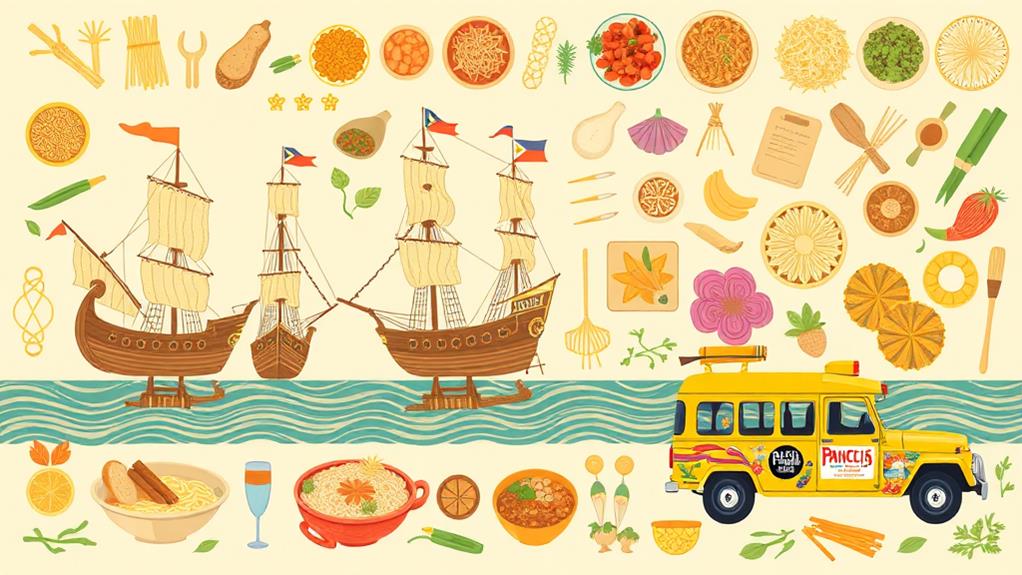
Pancit's Origins in the Philippines
Pancit originated from Chinese merchants introducing noodles in the 1500s. These Chinese merchants brought noodles to the Philippines, which eventually incorporated local ingredients and flavors over time.
The term "pancit" itself is derived from the Hokkien word for "convenient food," reflecting its adaptation to the Filipino culinary context.
Regional Variations
Different regions developed unique styles and variations of pancit. For example, Pancit Malabon and Pancit Bihon are two popular variations that showcase local tastes and cultural influences.
These regional variations demonstrate the adaptability and creativity of Filipino cuisine.
Pancit's Evolution in Filipino Culture
Pancit transformed from a simple meal for factory workers to a beloved dish at celebrations. Today, pancit symbolizes long life and good fortune in Filipino culture.
Its significance is evident in its presence at special occasions such as birthdays, weddings, and holidays.
The Rise of Panciterias
The rise of panciterias (noodle houses) during the Spanish colonization marked a significant shift in pancit's popularity.
Panciterias made pancit a staple in Filipino culinary traditions and social gatherings. This development cemented pancit's place in Filipino cuisine and culture.
Frequently Asked Questions
What Are the Different Types of Pancit?
Pancit Variations
There are various pancit variations, each with its own regional specialties and cooking methods. Canton pancit, for instance, is made with thicker, chewier noodles, while Bihon pancit is made with thin, delicate noodles. These differences in texture and flavor are due to the varying ingredients and cooking methods used in different regions.
Regional Specialties
Each type of pancit has its own unique historical significance and cultural influences. Lomi pancit, for example, is a popular variation from Batangas, known for its thick, chewy noodles and savory sauce.
Misua pancit, on the other hand, is a thin, salted noodle soup originating from the Visayas region.
Garnishes and Serving Traditions
Pancit noodles can be served with a range of garnishes, including vegetables, meat, or seafood. Palabok pancit, a popular variation from the northern region, is often served with a sweet and savory sauce, topped with crushed pork cracklings and boiled eggs.
Nutritional Aspects
The nutritional value of pancit noodles varies depending on the type and ingredients used.
Canton pancit, made with wheat flour, is a good source of carbohydrates, while Bihon pancit, made with rice flour, is gluten-free and lower in calories.
What Is a Fun Fact About Pancit?
Pancit is often served during birthdays in the Philippines because it symbolizes long life and good fortune.
This tradition stems from Chinese culture, where noodles represent longevity and prosperity.
In the Philippines, serving pancit during birthdays is believed to bring good luck and a long, healthy life to the celebrant.
What Is the Difference Between Pancit Bihon and Pancit Canton?
Pancit Bihon and Pancit Canton are two distinct types of Filipino noodles that differ in their noodle composition and characteristics.
Pancit Bihon noodles are made from thin rice flour and are known for their ability to soak up flavors well. This is due to their thin and delicate structure, which allows them to absorb seasonings and sauces easily.
As a result, Bihon is often stir-fried with soy sauce and vegetables, which enhances its flavor profile.
On the other hand, Pancit Canton noodles are made from a combination of wheat flour and eggs, making them thicker and chewier than Bihon.
This difference in composition affects their cooking technique, as Canton noodles require a longer cooking time to achieve the desired texture.
Canton's flavor profile is often richer and more umami, thanks to the use of oyster sauce, and may include seafood ingredients such as shrimp or pork.
Why Is Pancit Important to the Filipino Culture?
Pancit holds immense cultural significance in Filipino cuisine. This dish symbolizes long life and prosperity, often taking center stage at family gatherings and festive celebrations.
In Filipino culture, pancit represents a blend of Chinese influences and local flavors, reflecting the country's historical origins.
Sharing a plate of pancit is an act of communal sharing, a tradition that brings people together. This comfort food is often served at family gatherings and celebrations, fostering a sense of community and togetherness.
Modern adaptations of pancit have made it a popular dish, with various regional versions emerging across the Philippines.
